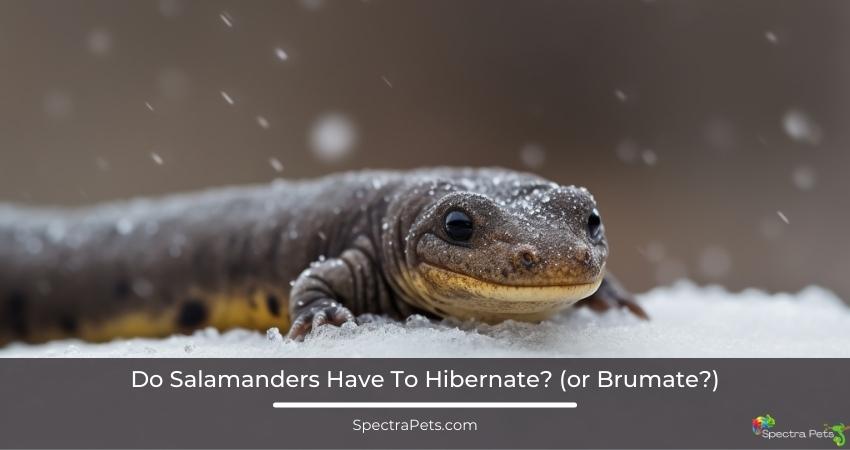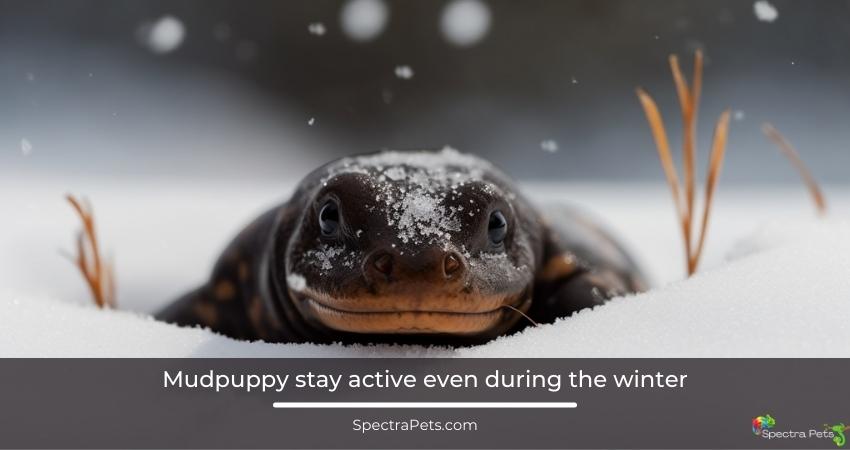As winter comes, a lot of us pet owners prepare for what’s to come and try to make the most favorable conditions for our little gremlins. Common pets are easy, but something that might confuse an owner would be a salamander, especially those who are new at raising one. Because they might not know how salamander behaves in winter.
Whether it’s a terrestrial salamander or an aquatic one, the core pattern is the same for them in winter. They try to bury themselves and hide under cover. I know what you’re thinking – but no, it’s not hibernation, although both have a similar process. Experts call this “Brumation”.
Haven’t heard the term? I guessed so. You’d learn more as you go. So why not keep scrolling downward and find out as you go…

Differences Between Hibernation and Brumation
We know that salamanders are cold-blooded creatures, but they’re amphibians, not mammals. Should they have been mammals, they’d go into hibernation, but what about a salamander?
Well, salamanders go through a somewhat similar ordeal, and it’s dubbed brumation.
We are all more or less aware of hibernation. But, what about brumation?
Hibernation and brumation are both processes that allow animals to conserve energy and survive during periods of adverse weather conditions or food scarcity. However, there are some key differences between the two. I have prepared a comparison table for you to take a quick look at.
| Aspect | Hibernation | Brumation |
|---|---|---|
| Types of Animals | Associated with endothermic animals (mammals) | Associated with ectothermic animals (reptiles, amphibians) |
| Metabolism | Significant slowdown; decreased body temperature, heart rate, and breathing rate | Metabolism slows down, but body temperature and other vital signs may not change as dramatically |
| Duration | Several months | A few weeks to a few months |
| Activity Levels | Completely inactive; no eating, drinking, or movement | May still be somewhat active; can emerge if weather warms up temporarily |
| Purpose | Conserve energy and survive during adverse conditions | Conserve energy and survive during adverse conditions, but specific triggers and adaptations may differ between species |
Types Of Animals
Hibernation is typically associated with mammals, such as bears and bats, while brumation is more common in reptiles and amphibians, such as snakes and salamanders. So… one is for endothermic animals, while the other is for ectothermic.
Metabolism
During hibernation, an animal’s metabolism slows down significantly, and its body temperature, heart rate, and breathing rate all decrease. In contrast, during brumation, an animal’s metabolism may slow down, but its body temperature and other vital signs may not change as dramatically.
Duration
Hibernation can last for several months, while brumation is usually shorter, lasting only a few weeks to a few months.

Activity Levels
Hibernating animals are completely inactive and do not eat, drink, or move around much during this time. In contrast, animals that are brumating may still be somewhat active and may emerge from their hiding spot if the weather warms up temporarily.
Purpose
Both hibernation and brumation serve as ways for animals to conserve energy and survive during periods of adverse conditions. However, the specific triggers and adaptations that cause these processes to occur may differ between species.
Do Salamanders Have To Hibernate? (or Brumate?)
As I’ve already mentioned, salamanders go into brumation, which is quite similar to the process of hibernation.
During brumation, salamanders will burrow underground or seek out a sheltered spot to spend the winter. They will often seek out moist, humid environments, such as under logs or rocks, in order to avoid drying out.
While in brumation, salamanders will not eat or drink, and their metabolism will slow down significantly. They will also not be very active, remaining mostly motionless for the duration of the winter.

However, unlike true hibernation, salamanders are not completely inactive during brumation. They may occasionally move around or even emerge from their hiding spot if the weather warms up temporarily.
Brumation serves an important purpose for salamanders, as it helps them conserve energy and survive the colder months when food is scarce. It also helps them to avoid predators and extreme weather conditions.
Once spring arrives, salamanders will emerge from their winter hiding spots and begin to mate and reproduce. They will also start to eat and drink again, increasing their activity levels as the weather warms up.
How Long Do Salamanders Hibernate For?
The length of time that a salamander will spend in brumation will depend on a number of factors, including the species of salamander, the climate in which it lives, and the availability of food and shelter. In general, brumation lasts for a few weeks to a few months.
Where Do Salamanders Go In The Winter?
Different species of salamanders are adapted to different kinds of environments. And because of this, they have implemented different kinds of strategies when going into brumation. Let’s have a closer look at what different types of salamanders do during the winter:
Terrestrial Salamanders:
Terrestrial salamanders, or salamanders that live on land, will typically seek out a sheltered spot to spend the winter months in order to go through brumation. The specific spot that a terrestrial salamander will choose to brumate will depend on the availability of suitable shelter and the specific needs of the species.
To find a suitable spot to brumate, terrestrial salamanders will often burrow underground or seek shelter in logs, rocks, or other natural cavities. They may also use abandoned burrows or other underground structures as a place to spend the winter.
Moreover, Salamanders are adapted to survive in moist, humid environments, so they will often choose a spot that provides some protection from drying out. They may also seek out spots that provide some protection from extreme weather conditions and predators.
Aquatic Salamanders
Well, an aquatic salamander will never survive out of water. Therefore, they tend to brumate only in aquatic environments.
However, there are some key requirements that the water body must fulfill. The water must have a good amount of oxygen content and not freeze at the bottom.

During winter, these aquatic creatures will swim to the bottom of the water where the water will not freeze, and may even dig a spot for themselves under the mud. Once the winter is over, they will emerge back from brumation.
Some aquatic salamanders, such as the mudpuppy and the hellbender, decide to stay active even during the winter. They will just stay active in deep water that doesn’t freeze and fast-flowing streams.
What Time of the Year are Salamanders Most Active?
Salamanders are most active during the warmer months of the year when their metabolism is faster, and they have access to more food. In general, salamanders are more active at temperatures between 50–75 degrees Fahrenheit (10–24 degrees Celsius).
During the spring and summer, salamanders will emerge from their winter hiding spots and begin to mate and reproduce. They will also start to eat and drink again, increasing their activity levels as the weather warms up.
In the fall, salamanders will start to prepare for the winter by finding a sheltered spot to spend the colder months. They may also start to eat more to build up their energy reserves in preparation for brumation.
During the winter, salamanders will be in a state of brumation, during which they will be less active and may not eat or drink. However, they may still emerge from their hiding spot if the weather warms up temporarily.
Can Salamanders Survive In the Snow?

Salamanders are ectothermic, or cold-blooded, animals, which means that their body temperature is regulated by the environment. In cold temperatures, their metabolism slows down, and they become less active.
Salamanders are generally adapted to live in moist, humid environments and may not survive long in dry, cold conditions such as snow. However, some species of salamanders are able to survive in snowy environments by burrowing underground or seeking shelter in logs or rocks.
For example, the Alpine salamander (Salamandra atra), which is found in the Alps in Europe, is adapted to survive in cold, snowy conditions. It burrows underground to escape the cold and emerges in the spring when the weather warms up.
What Do You Do If You Find A Hibernating Salamander In The Winter?
If you come across a salamander that appears to be hibernating, it is important to respect the animal’s natural behavior and leave it undisturbed. Salamanders, like many other animals, rely on their natural patterns of behavior, including brumation, to survive the winter months.
Interrupting a salamander’s brumation can cause stress and interfere with its ability to survive the winter. It can also expose the animal to potential predators or other dangers.
If you find a salamander that appears to be in distress, it is important to seek the advice of a wildlife rehabilitation center or a professional who is trained to handle and care for these animals. It is best to observe these hibernating amphibians from a distance and avoid disturbing them.
Do Pet Salamanders Need To Hibernate?

If you have a pet salamander, it is important to provide it with the proper care and conditions to ensure its health and well-being. This may include replicating the natural conditions that a salamander would experience in the wild, such as a suitable temperature range and access to moisture.
As long as you are properly tending to your pet salamander’s needs, it is generally not necessary for it to go through a period of brumation. Instead, you can provide your salamander with suitable habitat and care for it throughout the year.
However, it is important to note that different species of salamanders may have different care requirements, and it is important to research the specific needs of the species you are keeping as a pet.
If the temperatures in the enclosure become too low, your pet amphibian may start preparing for brumation. They will be showing several indications of these preparations. These include:
- Hiding
- Sleeping and being inactive for most of the time
- Lack of appetite
If you see these behavior patterns in your pet, then you may want to check the temperature of the terrarium!
Wrapping Up
Let’s do a recap- salamanders go into brumation to avoid the winter cold, there are some of its species that can actually stay normal as if its Sunday morning, and most importantly, if you provide your pet salamander with a favorable environment then it might not even need to go into hibernation (or brumation to be precise).
So, my friend, do you think you’ve learned something valuable? Share it with us in the comments.

